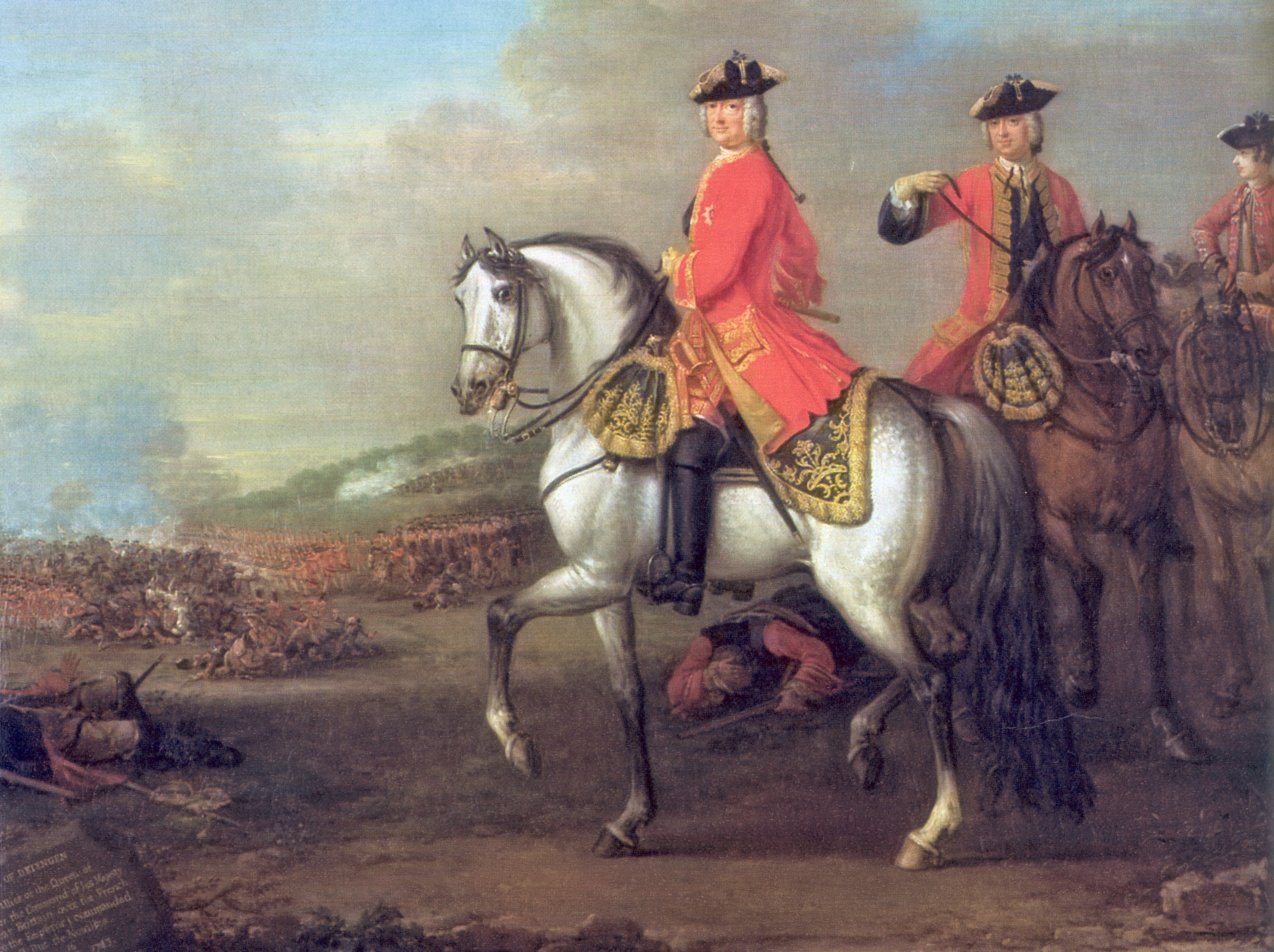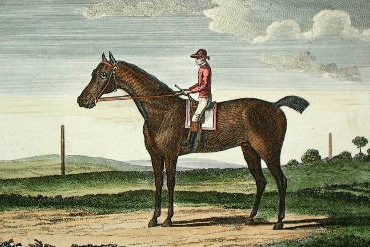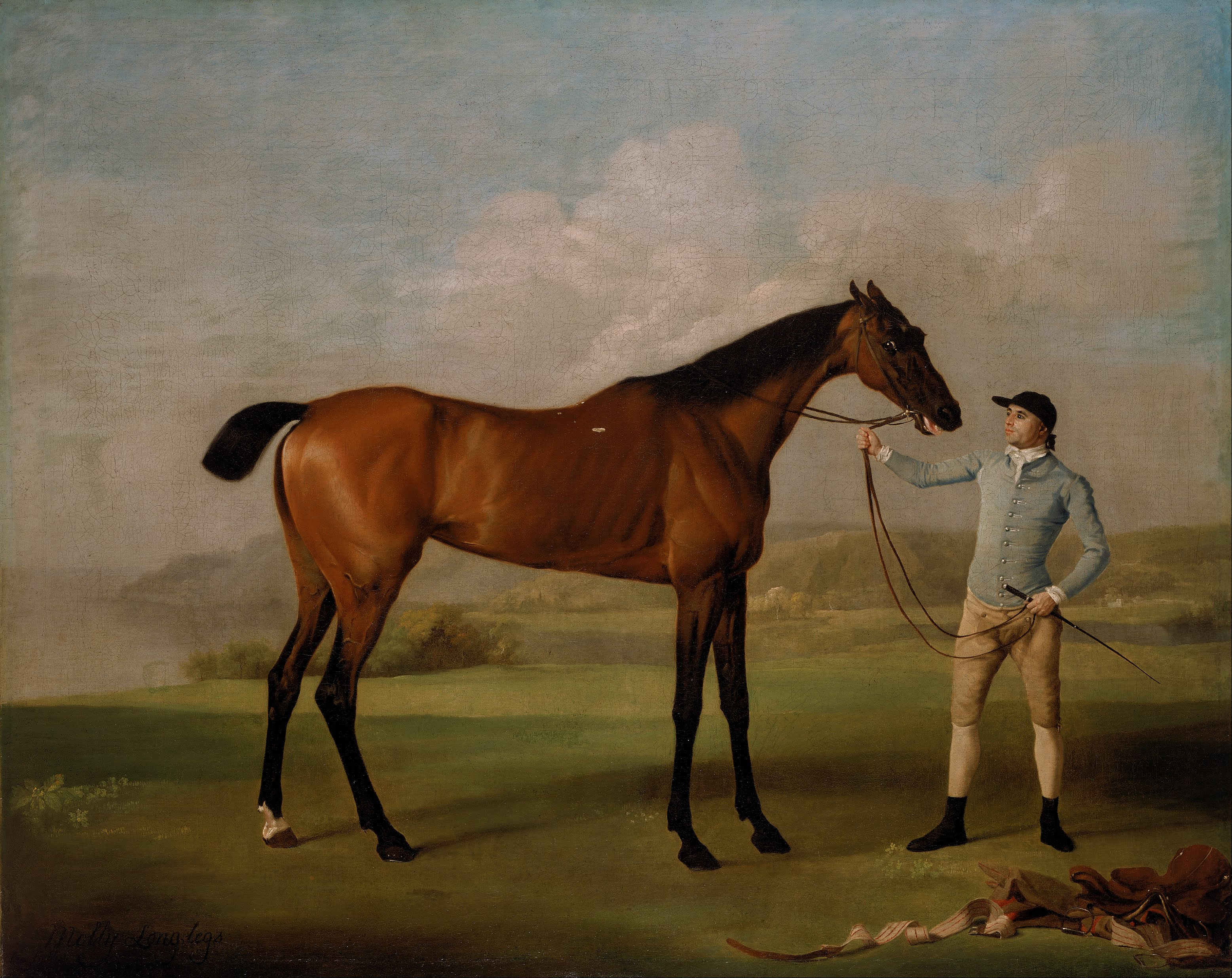|
Darley Arabian
The Darley Arabian (foaled c. 1700) was one of three dominant foundation sires of modern Thoroughbred horse racing bloodstock. The other two founders were the Godolphin Arabian and the Byerley Turk. This bay Arabian horse was bought in Aleppo, Syria, by Thomas Darley in 1704 and shipped to Aldby Park in England, as a present for his brother. One author in 1840 described Darley Arabian's arrival in England during the reign of Queen Anne as the event which "forms the great epoch from which the history of the Turf '' turf racing"">Flat_racing.html" ;"title="s in "Flat racing">turf racing"' should be dated". There he stood at stud, usually private but sometimes open to outside mares. He was the leading sire in Great Britain and Ireland in 1722. By all accounts, the Darley Arabian stood about 15 hands high and was of substantial beauty and refinement.Ahnert, Rainer L. (editor in chief), "Thoroughbred Breeding of the World", Pozdun Publishing, Germany, 1970 The Darley Arabian ... [...More Info...] [...Related Items...] OR: [Wikipedia] [Google] [Baidu] |
John Wootton
John Wootton (c.1686– 13 November 1764)Deuchar, S. (2003). "Wootton, John". Grove Art Online. was an English painter of sporting subjects, battle scenes and landscapes, and illustrator. Life Born in Snitterfield, Warwickshire (near Stratford-upon-Avon), he is best remembered as a pioneer in the painting of sporting subjects – together with Peter Tillemans and James Seymour – and was considered the finest practitioner of the genre in his day. As such, his paintings were very fashionable and were sought after by those among the highest strata of the British society. These included figures such as George II of Great Britain, Frederick, Prince of Wales, and the Duke of Marlborough. It is likely that he received artistic training from Jan Wyck before 1700. Wootton may have begun life as a page to the family of the Dukes of Beaufort. His earliest surviving dated work is the equine portrait ''Bonny Black'' (1711). He remained active until his death in 1764, based in the capit ... [...More Info...] [...Related Items...] OR: [Wikipedia] [Google] [Baidu] |
Flying Childers
Flying Childers (1715–1741) was a famous undefeated 18th-century thoroughbred racehorse, foaled in 1714 at Carr House, Warmsworth, Doncaster, and is sometimes considered as the first truly great racehorse in the history of thoroughbreds and the first to catch the public imagination. Breeding Flying Childers was sired by the great Darley Arabian, one of the three foundation stallions of the thoroughbred breed. His dam, Betty Leedes, was by (Old) Careless, and she was inbred to Spanker in the second and third generations (2x3). Betty Leedes was also the dam of the unraced, but successful sire, Bartlett's or Bleeding Childers who was also by the Darley Arabian. (Old) Careless was by the great stallion Spanker, and both were thought to be the best racehorses of their generation.Ahnert, Rainer L. (editor in chief), ''Thoroughbred Breeding of the World'', Pozdun Publishing, Germany, 1970 Betty Leedes was one of the few outside mares allowed to breed to the Darley Arabian, who was mo ... [...More Info...] [...Related Items...] OR: [Wikipedia] [Google] [Baidu] |
Goldfinder (horse)
Goldfinder (1764–1789) was an undefeated Thoroughbred racehorse. His wins included two Newmarket Challenge Cup and Whips. After retiring from racing he became a successful sire. Background Goldfinder was a bay colt foaled in 1764. He was bred by John St Leger Douglas and was sired by the undefeated racehorse and Champion sire Snap. His dam was a daughter of Blank, another Champion sire. Racing career Goldfinder made his racecourse debut at Newmarket on 5 April 1768, beating two opponents to win a sweepstakes of 200 guineas each (known as the 1400 Guineas). On 29 April he beat six rivals to win the Ascot Stakes. His next race came in October, where he beat five rivals (including Lord Bolingbroke's 4/5 favourite Sejanus) to win another sweepstakes of 200 guineas each. The next day he was due to race a filly belonging to Sir John Moore, but Moore paid a 300 guinea forfeit and withdrew his horse. In his last race as a four-year-old he won the Contribution Stakes, beating four ... [...More Info...] [...Related Items...] OR: [Wikipedia] [Google] [Baidu] |
Snap (horse)
Snap (1750 – July 1777) was a Thoroughbred racehorse who won all four of his races. After retiring from racing he became a successful stallion. He was Champion sire four times and his progeny included the undefeated Goldfinder. Background Snap was a brown colt foaled in 1750. Bred by Cuthbert Routh and Lord Portmore, as a yearling he was valued at £70. Snap's sire was Snip, a son of the undefeated Flying Childers. His dam was a sister to Slipby and a daughter to Fox. He was sold to Jenison Shafto when Cuthbert Routh died in 1752. Racing career Snap's first race came in the spring of 1756 at Newmarket, where he beat Marske to win 1000 guineas. Both horses were carrying ten stone in weight. In the following meeting at Newmarket he again beat Marske for 1000 guineas off level weights, after starting as the 1/10 favourite he won easily. Snap beat Farmer and Music to win the £100 Free Plate, which was run in four mile heats. The Free Plate was run at York, his only race aw ... [...More Info...] [...Related Items...] OR: [Wikipedia] [Google] [Baidu] |
Snip (horse)
Snip (1736 – 8 May 1757) was a British Thoroughbred racehorse. He only won one race, but later became a successful sire. His son Snap was undefeated in his four races and became a multiple-time Champion sire. Snip was bred and owned by William Cavendish, 3rd Duke of Devonshire. Background Snip was a Equine coat color#Basic coat, brown Colt (horse), colt bred by the William Cavendish, 3rd Duke of Devonshire, 3rd Duke of Devonshire and foaled in 1736. He was sired by the undefeated racehorse and Champion sire Flying Childers, who also sired Blaze (horse), Blaze. Snip's Mare, dam was a daughter of Basto (horse), Basto. Racing career Snip's first race was in 1741 at Beccles in Suffolk, where he beat Thirkleby, Fancy and three others in a £50 race of two heats. He later raced at Newmarket Racecourse, Newmarket, but was unsuccessful. Stud career Despite his race record he apparently appealed to breeders due to his good Equine conformation, conformation. He stood as a stalli ... [...More Info...] [...Related Items...] OR: [Wikipedia] [Google] [Baidu] |
Norfolk Trotter
The Norfolk Trotter is a historical horse breed once native to East Anglia and Norfolk, England. It was said to be "a large-sized trotting harness horse originating in and around Norfolk". In 1542, King Henry VIII required the wealthy to keep a specified number of trotting-horse stallions. The breed was well established in Norfolk, and later became known as the Norfolk Trotter. The most influential sire in its history is the half-bred stallion Shales (foaled 1755), also known as "Old Shales". Shales' Thoroughbred sire, Blaze (foaled 1733), was a son of the great racehorse Flying Childers (a descendant of the Darley Arabian, one of the three foundation sires of the Thoroughbred). The Norfolk Trotter became the all-around travel horse in England at this time. In Yorkshire, the same breed was known as the Yorkshire Trotter. Both breeds were also known as roadsters. The term Norfolk/Yorkshire Roadster/Trotter is seen commonly in breed-history books; regardless of the name, all are th ... [...More Info...] [...Related Items...] OR: [Wikipedia] [Google] [Baidu] |
Bay Malton
Bay Malton (1760-1786) was a successful British Thoroughbred racehorse of the 18th century. A bay horse, as the name would suggest, he was bred by a Mrs. Ayrton of Malton and foaled in 1760. He was sired by Sampson, and was a full brother to Treasurer. In May 1764, in the name of Mr. Fenton, owner of his brother Treasurer, Bay Malton made his racecourse debut and won a 160 guinea sweepstake against Mr. Thompson's Snap. After this he was sold to the Marquis of Rockingham. For Lord Rockingam he won a 500 guinea sweepstake over the Beacon course at Newmarket in April 1765. Later that year, Bay Malton beat the esteemed Gimcrack, thought to be the best horse in Newmarket, 'very easy'. Amongst other important victories, he won the Great Subscription Purse at York, beating the horse that would be one of the future major sires in racing, Herod. His most memorable victory came at Newmarket's second Spring Meeting in April 1767 where he beat Herod again, Turf and Ascham in a race that wa ... [...More Info...] [...Related Items...] OR: [Wikipedia] [Google] [Baidu] |
Engineer (horse)
Engineer (foaled c. 1756) was a brown English Thoroughbred stallion bred by William Fenton of Glass House, near Leeds, Yorkshire. His outstanding son was Mambrino, although he sired some good race horses, such as King's Plate winner Fireworker, and Black Tom, a number of his daughters gained distinction as broodmares A mare is an adult female horse or other equine. In most cases, a mare is a female horse over the age of three, and a filly is a female horse three and younger. In Thoroughbred horse racing, a mare is defined as a female horse more than four y .... Pedigree References External linksProfile at Bloodlines.net Racehorses bred in the United Kingdom 1750s racehorse births {{Racehorse-stub ... [...More Info...] [...Related Items...] OR: [Wikipedia] [Google] [Baidu] |
Blacklegs (horse)
Blacklegs (foaled 1728) was a British Thoroughbred racehorse and sire who was the champion sire of Great Britain in 1746. He was bred by William Cavendish, 2nd Duke of Devonshire, and owned by his son William Cavendish, 3rd Duke of Devonshire. Background Blacklegs was a bay colt bred by William Cavendish, 2nd Duke of Devonshire, and foaled in 1728. He was sired by the Duke of Devonshire's Flying Childers, who was undefeated in six starts as a racecourse. Flying Childers was also a successful stallion and was champion sire of Great Britain twice. Amongst his other progeny were the sires Blaze and Snip, along with Second, Spanking Roger and Roundhead. Blacklegs' dam was an unnamed daughter of Basto. This Basto mare also foaled the champion sire Crab, as well as the previously mentions Snip and Second. After the 2nd Duke of Devonshire's death in 1729, Blacklegs was owned by his son and successor William Cavendish, 3rd Duke of Devonshire. Racing career In October 1732 at Newma ... [...More Info...] [...Related Items...] OR: [Wikipedia] [Google] [Baidu] |
Spark (horse)
Spark was a Thoroughbred stallion who was among the early imports of Thoroughbred horses to America. The Belair Stud stables were associated with him and a mare, Queen Mab, also imported in this period. Frederick, Prince of Wales gave the stallion to Samuel Ogle, the governor of Maryland, as a gift. Background Spark was foaled in 1743. He was bred by and originally the property of Charles Fleetwood, Esquire. Fleetwood gave Spark to Frederick Louis, the Prince of Wales. The Prince of Wales, gave the stallion to Lord Baltimore to give to Samuel Ogle, Provincial Governor of Maryland as a present. Spark was already known in the British Isles. An 1898 account described Spark as the "first pedigree horse" imported to Maryland. One account states that Ogle took Spark back to the American Colonies from England in the Spring of 1747. Another says that Lord Baltimore gave the horse to Ogle "about" 1750. This was Ogle's last tour of duty to replace Thomas Bladen, the past governor of ... [...More Info...] [...Related Items...] OR: [Wikipedia] [Google] [Baidu] |
Whistlejacket
''Whistlejacket'' is an oil on canvas painting from about 1762 by the British artist George Stubbs showing the Marquess of Rockingham's racehorse approximately at life-size, rearing up against a plain background. The canvas is large, lacks any other content except some discreet shadows, and Stubbs has paid precise attention to the details of the horse's appearance. It has been described in ''The Independent'' as "a paradigm of the flawless beauty of an Arabian thoroughbred". The Fitzwilliam family, heirs of the childless Rockingham, retained the painting until 1997 when funding from the Heritage Lottery Fund allowed the National Gallery, London to acquire it for £11 million. Stubbs was a specialist equine artist who in 1762 was invited by Rockingham to spend "some months" at Wentworth Woodhouse in Yorkshire, his main country house. Stubbs had painted many horse portraits, with and without human figures, but the heroic scale and lack of background of ''Whistlejacket'' are " ... [...More Info...] [...Related Items...] OR: [Wikipedia] [Google] [Baidu] |
Y Chromosome
The Y chromosome is one of two sex chromosomes (allosomes) in therian mammals, including humans, and many other animals. The other is the X chromosome. Y is normally the sex-determining chromosome in many species, since it is the presence or absence of Y that determines the male or female sex of offspring produced in sexual reproduction. In mammals, the Y chromosome contains the gene SRY, which triggers male development. The DNA in the human Y chromosome is composed of about 59 million base pairs, making it similar in size to chromosome 19. The Y chromosome is passed only from father to son. With a 30% difference between humans and chimpanzees, the Y chromosome is one of the fastest-evolving parts of the human genome. The human Y chromosome carries an estimated 100–200 genes, with between 45 and 73 of these being protein-coding. All single-copy Y-linked genes are hemizygous (present on only one chromosome) except in cases of aneuploidy such as XYY syndrome or XXYY syndrome. ... [...More Info...] [...Related Items...] OR: [Wikipedia] [Google] [Baidu] |





